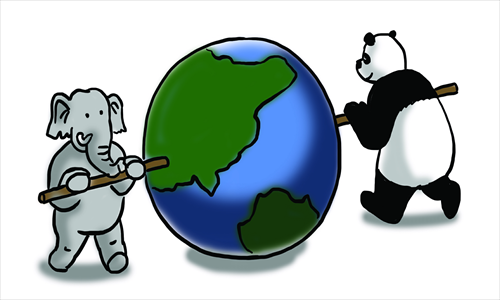Sino-Indian media help advance ties
http://www.globaltimes.cn/content/814708.shtml#.UlHW5RBJCuY
http://www.globaltimes.cn/content/814708.shtml#.UlHW5RBJCuY
| Global Times | 2013-9-28 20:13:02 By Lu Jingxian |

Illustration: Liu Rui/GT
Nawang Dorjai was our Chinese-speaking tour guide in Mumbai. According to him, India has less than 30 tour guides who can speak Chinese. It's a pathetic figure given that India has rich tourist resources and China's outbound tourism market is exploding, and that the two countries have set the ambitious goal for the bilateral trade volume to reach $100 billion by 2015.
In India, one doesn't see the throngs of Chinese tourists commonly seen in other countries. The number of Indians visiting China is equally small. There is no daily direct flight between the capitals of the two most populous countries. But on the official level, the importance of a strategic comprehensive partnership is noted.
(There is at least one flight between N Delhi and Beijing. I have myself traveled. May not be daily!!
In May, Chinese Premier Li Keqiang made India his first overseas visit after taking office. Indian Prime Minister Manmohan Singh is scheduled to visit China this autumn, realizing the first prime ministerial level visit exchange in one year between the two countries since 1954.
Yet the media of China and India seem to have been dominated by territorial disputes and various internal plagues of each other.
The presumed "threat" from China permeates coverage of China in Indian media. This sentiment is taken by Chinese media as "provocation" from India.
Is the media to be blamed for the unfriendly sentiment between public of China and India? Is it possible for media outlets from both sides to work together to improve bilateral relations? These questions were raised at the first India-China media forum held this month.
The media has a natural tendency to pursue negative stories and conflict. Meanwhile, territorial interests are associated with a kind of national pride that no media can detach from. The relationship with the media is a delicate task for any government, whatever for domestic or foreign affairs.
Indian media professionals take pride in the country's democratic system and the corresponding media structure. This is also a prevailing view among Western press professionals. In their opinion, private ownership and market competition allow them little room to follow the government's wishes.
Perhaps they think their Chinese counterparts are much more dictated to by officialdom. But with the gradual market-oriented transformation, Chinese media have to increasingly respond to demand from readers and the market.
Even the small number of official media outlets have to cater to the public to maintain their influence or avoid being marginalized. International reporting, including coverage of India, is among the most free fields of Chinese reporting. It is no longer the time when diplomatic news in Chinese press was only just hand-shaking and symbolic rhetoric.
But the media should be careful that unleashing nationalist sentiment might seriously undermine foreign relationships.
Take the Diaoyu Islands issue for example, which in a few short months froze Sino-Japanese ties and put the whole economic exchange in jeopardy. Imagine what it would mean if China and India turned totally against each other. Fortunately, it is still possible to prevent the India-China boundary issue from becoming too hot to touch.
Though the memory of the shadow of war is still there, the two civilizations harbor no deep hatred toward each other. The two governments are also rational enough to keep boundary issue from escalating.
Both countries used to attach more importance to their ties with the West. Even though there is still suspicion about "encirclement," today's India-China ties are at their best in decades.
Asia's two leading countries can offer much more to the world. Territorial dispute should not eclipse the shared interests between New Delhi and Beijing. In areas such as the new global financial order and energy price mechanism, the joint influence of China and India is formidable.
At the beginning of the 18th century, China and India were indisputably the two leading civilizations in the world. They lost their status in the following centuries. Today the two countries are both on the road of rejuvenation. It is crucial that they have a better understanding of each other.
The author is deputy managing editor of the Global Times. lujingxian@globaltimes.com.cn

No comments:
Post a Comment